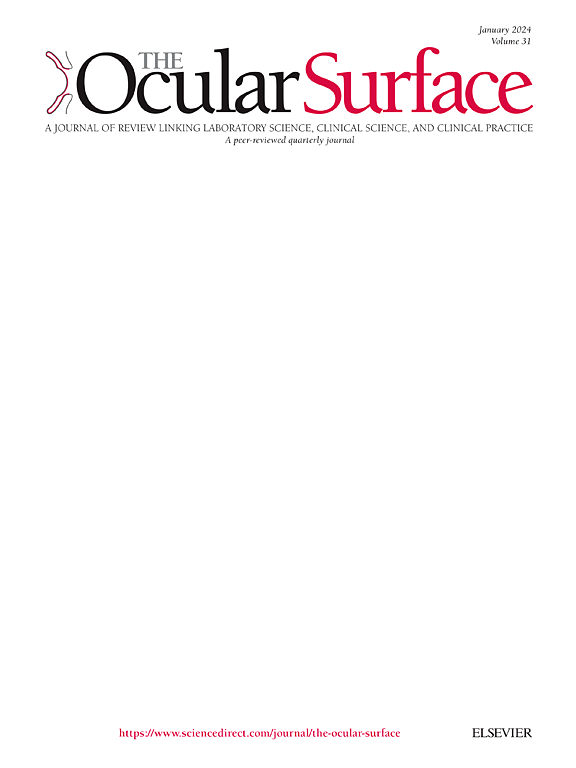Bringing ophthalmology into the scientific world: Novel nanoparticle-based strategies for ocular drug delivery
IF 5.6
1区 医学
Q1 OPHTHALMOLOGY
引用次数: 0
Abstract
The distinctive benefits and drawbacks of various drug delivery strategies to supply corneal tissue improvement for sense organs have been the attention of studies worldwide in recent decades. Static and dynamic barriers of ocular tissue prevent foreign chemicals from entering and inhibit the active absorption of therapeutic medicines. The distribution of different medications to ocular tissue is one of the most appealing and demanding tasks for investigators in pharmacology, biomaterials, and ophthalmology, and it is critical for cornea wound healing due to the controlled release rate and increased drug bioavailability. It should be mentioned that the transport of various types of medications into the different sections of the eye, particularly the cornea, is exceedingly challenging because of its distinctive structure and various barriers throughout the eye. Nanoparticles are being studied to improve medicine delivery strategies for ocular disease. Repetitive corneal drug delivery using biodegradable nanocarriers allows a medicine to remain in different parts of the cornea for extended periods of time and thus improve administration route effectiveness. In this review, we discussed eye anatomy, ocular delivery barriers, as well as the emphasis on the biodegradable nanomaterials ranging from organic nanostructures, such as nanomicelles, polymers, liposomes, niosomes, nanowafers, nanoemulsions, nanosuspensions, nanocrystals, cubosomes, olaminosomes, hybridized NPs, dendrimers, bilosomes, solid lipid NPs, nanostructured lipid carriers, and nanofiber to organic nanomaterials like silver, gold, and mesoporous silica nanoparticles. In addition, we describe the nanotechnology-based ophthalmic medications that are presently on the market or in clinical studies. Finally, drawing on current trends and therapeutic approaches, we discuss the challenges that innovative optical drug delivery systems confront and propose future research routes. We hope that this review will serve as a source of motivation and inspiration for developing innovative ophthalmic formulations.

将眼科带入科学世界:新型纳米颗粒为基础的眼部药物输送策略。
近几十年来,为改善感官器官角膜组织而采用的各种给药策略的独特益处和弊端一直是全球研究的焦点。眼组织的静态和动态屏障会阻止外来化学物质进入,并抑制治疗药物的有效吸收。对于药理学、生物材料学和眼科学研究人员来说,将不同药物分配到眼部组织是最吸引人也是最艰巨的任务之一,而且由于可控释放率和药物生物利用度的提高,这对角膜伤口愈合至关重要。值得一提的是,由于角膜的独特结构和整个眼球的各种屏障,将各种药物输送到眼球的不同部分,尤其是角膜,是一项极具挑战性的工作。目前正在对纳米颗粒进行研究,以改进眼部疾病的给药策略。使用可生物降解的纳米载体在角膜上重复给药,可使药物在角膜的不同部位停留较长时间,从而提高给药途径的有效性。在这篇综述中,我们讨论了眼部解剖、眼部给药屏障,并重点介绍了可生物降解的纳米材料,包括有机纳米结构,如纳米细胞、聚合物、脂质体、niosomes、纳米晶片、纳米乳液、纳米悬浮液、纳米晶体、立方体、橄榄体、杂化 NPs、树枝状分子、双体、固态脂质 NPs、纳米结构脂质载体和纳米纤维,以及银、金和介孔二氧化硅纳米粒子等有机纳米材料。此外,我们还介绍了目前已上市或正在进行临床研究的基于纳米技术的眼科药物。最后,我们借鉴当前的趋势和治疗方法,讨论了创新型光学给药系统所面临的挑战,并提出了未来的研究路线。我们希望这篇综述能成为开发创新眼科制剂的动力和灵感来源。
本文章由计算机程序翻译,如有差异,请以英文原文为准。
求助全文
约1分钟内获得全文
求助全文
来源期刊

Ocular Surface
医学-眼科学
CiteScore
11.60
自引率
14.10%
发文量
97
审稿时长
39 days
期刊介绍:
The Ocular Surface, a quarterly, a peer-reviewed journal, is an authoritative resource that integrates and interprets major findings in diverse fields related to the ocular surface, including ophthalmology, optometry, genetics, molecular biology, pharmacology, immunology, infectious disease, and epidemiology. Its critical review articles cover the most current knowledge on medical and surgical management of ocular surface pathology, new understandings of ocular surface physiology, the meaning of recent discoveries on how the ocular surface responds to injury and disease, and updates on drug and device development. The journal also publishes select original research reports and articles describing cutting-edge techniques and technology in the field.
Benefits to authors
We also provide many author benefits, such as free PDFs, a liberal copyright policy, special discounts on Elsevier publications and much more. Please click here for more information on our author services.
Please see our Guide for Authors for information on article submission. If you require any further information or help, please visit our Support Center
 求助内容:
求助内容: 应助结果提醒方式:
应助结果提醒方式:


